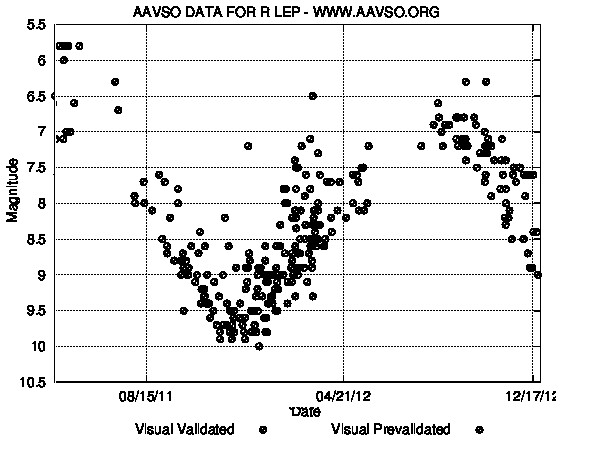It was mostly clear last night. I thought it might be fun to see if i could find R Laporis, also called Hind's Crimson Star. Though visible from my back yard, which has better stray light blocking, it did not appear that i could get my telescope's computer aligned in a spot where i could see it. So, i brought the scope to the front sidewalk (the Mercury Vapor Observatory). The MVO has had a much wider sky view than the jungle in the back yard ever since the Emerald Ash Borer took down the front yard's twin gorgeous ash trees. I've never actually seen one of these beasts.
The constellation Lepus (the hare) is below the feet of Orion. This part of the sky looks entirely star free at first glance. 10x50 binoculars show the stars of the constellation easily. But after a few minutes, there seemed to be enough stars visible to the naked eye to sort of fill it in. At the MVO, there really isn't anything like dark adaptation for the eyes. It's more like scanning the area, paying attention, and using averted vision techniques to bring out the dimmer stars. I should note that the constellation looks more like LEPUS on the Orion wiki page than on the R Laporis wiki page.The ten inch scope cooled down, and i performed an alignment using Rigel and Polaris. Rigel was chosen because it's near the target. Polaris was chosen because it was handy. The computer reports how good the alignment was, and it was excellent. R Laporis is less than a degree above NGC 1710. NGC 1710 is a galaxy that is absolutely invisible from the Mercury Vapor Observatory, since it's not one of the three brightest galaxies in the sky. The idea was to get into the neighborhood. It took about a minute of searching to find it. My wife also got a look at it briefly, before clouds blocked it. It looks like a seriously red LED light. Orion's Betelgeuse is also a red supergiant. And it's nearby in the sky, so i took a look at it for comparison. While Betelgeuse is somewhat orangish naked eye, it looked positively white in the scope, though not white like Rigel. The difference for R Laporis is that the star pushes carbon into its atmosphere. This carbon blocks blue light from the otherwise red giant, making it look much, much redder.
R Leporis is fairly faint, at about 10th magnitude. This is not a problem at the MVO. This ten inch (254 mm) scope has a collecting area (with the secondary mirror subtracted) of 47,553 square millimeters. My eyes dilate to 6.5 mm, which works out to 33 square millimeters. So the scope brings in 1,433 times more light into my eyes. That works out to a light grasp improvement of about 7.9 magnitudes. I was seeing 4th magnitude stars naked eye, so 12th magnitude should have been reachable with the scope. In addition to that, even low magnification (48x) tends to dim extended objects like galaxies and the sky glow, but not point like objects like stars. So the contrast is much, much better. A tenth magnitude star is fairly bright in the scope. Unfortunately, I didn't get a chance to see if R Laporis was visible in the 9x50 finder scope. It wasn't obvious in the 10x50 binoculars, but i didn't yet know exactly where to look.
 R Laporis is a variable star with a period of about 432 days (14 months). It most recently peaked near magnitude 6 in November 2012. So it should be faintest in June 2013 near magnitude 11. Here's the current AAVSO light curve. To search for the star, use R LEP on the AAVSO web site. R Laporis should be at peak brightness again in January 2014 (about 40 times brighter). And, Orion, and therefore Lepus, will be well placed in the evening sky as well.
R Laporis is a variable star with a period of about 432 days (14 months). It most recently peaked near magnitude 6 in November 2012. So it should be faintest in June 2013 near magnitude 11. Here's the current AAVSO light curve. To search for the star, use R LEP on the AAVSO web site. R Laporis should be at peak brightness again in January 2014 (about 40 times brighter). And, Orion, and therefore Lepus, will be well placed in the evening sky as well.
It was freezing cold, so i limited myself to a few other objects. Polaris and Rigel were alignment stars. Though i could have aligned using the finder scope's cross hairs, the main scope was used. Betelgeuse, Rigel and Sirius were used for comparison. Sirius was blinding. Jupiter was above the first quarter moon. The four Galilean moons were clearly visible in 10x50 binoculars. I didn't look at the Moon with optics, as the sky was very clear, and the moon filter was in the house.




No comments:
Post a Comment